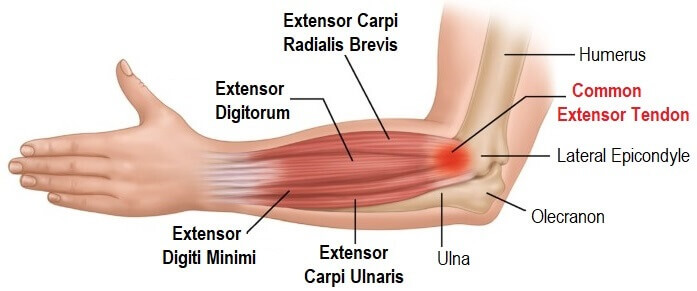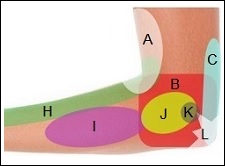- Home
- Elbow Pain Diagnosis
- Forearm Tendonitis
- Tennis Elbow
Lateral Epicondylitis
Written By: Chloe Wilson BSc (Hons) Physiotherapy
Reviewed By: SPE Medical Review Board
Lateral epicondylitis is the most common cause of outer elbow pain and can also extend down the forearm.
Whilst commonly known as tennis elbow, less than 10% of people with lateral epicondylitis actually play tennis! It is just as likely to affect office workers and manual workers as it is sports players.
Lateral epicondylitis is caused by overuse of the extensor muscles in the forearm and hand, typically from repetitive gripping, forearm twisting, heavy lifting and computer work.
Repetitive overuse of the forearm muscles leads to tendon damage and degeneration on the outer elbow resulting in lateral elbow and forearm pain and weakness.
Most cases of lateral epicondylitis are self-limiting and will get better by themselves within 6 months to 2 years, but with the correct treatments, you can reduce the symptoms and speed up the recovery time.
Here we will look at the common causes, symptoms, diagnosis and treatment options for lateral epicondylitis and prevention strategies.
What Is Tennis Elbow?
Lateral epicondylitis is an overuse injury of the forearm muscles, usually from occupational or sporting activities, and is the most common type of forearm tendonitis.
On the back of the forearm are a group of muscles that work together to extend the wrist and fingers, rotate the wrist and forearm, and help to control your grip:
- Extensor Carpi Radialis Brevis: extends and abducts the wrist/hand
- Extensor Digitorum: extends the fingers
- Extensor Carpi Ulnaris: extends and adducts the wrist/hand
- Extensor Digiti Minimi: extends the little finger

These muscles join together near the elbow to form the common extensor tendon. Tendons are thick, cord-like structures that work like a bridge to connect muscles to bone. The common extensor tendon attaches the forearm extensor muscles to the lateral epicondyle of the humerus, the bony lump that you can feel on the outer side of the elbow.
Repetitive overuse of the forearm muscles overloads the tendon which leads to micro-tearing in the tendon fibres. Initially, this causes inflammation in the common extensor tendon which progresses to degeneration. Collagen fibres become disorganized resulting in fibrous scar tissue, calcification and thickening. The tendon has a relatively poor blood supply which slows the healing process leading to progressive weakening of the tendon.
90% of cases of lateral epicondylitis occur at the teno-osseous junction, where the tendon attaches to the bone. The other 10% occur elsewhere in the tendon or in the muscle belly.
Tennis elbow is the most common cause of persistent elbow pain and affects approximately 2-3% of the population. Lateral epicondylitis typically affects the dominant hand and is equally prevalent in men and women. The next most common cause of outer elbow pain is radial tunnel syndrome.
Lateral epicondylitis is similar to medial epicondylitis, aka golfers elbow, which causes similar symptoms on the inner elbow.
Causes Of Lateral Epicondylitis
Lateral epicondylitis is typically caused by repetitive overuse and strain through the common extensor tendon from:
- Racket Sports: the combination of gripping and forearm rotation and extension is a common cause of lateral epicondylitis. Whilst commonly associated with tennis it can also affect badminton, squash, racquetball, paddleball and baseball players as well as those doing throwing sports e.g. discus and javelin. Less than 10% of cases of tennis elbow are actually due to racket sports!
- Computer Use: office workers are also prone to lateral epicondylitis. Repetitive typing and mouse-use requires lots of finger movement with the wrist in an extended position resulting in repetitive strain through the common extensor tendon. As a result lateral epicondylitis is becoming increasingly referred to as “computer elbow” or “mouse elbow”
- Manual Labour: Occupations that involve repetitive movements of the wrist and hand, particularly one-handed motions, often lead to lateral epicondylitis e.g. carpenters, electricians, gardeners, chefs, plumbers and painters & decorators
Certain factors can increase the risk of developing lateral epicondylitis:
- Age: whilst lateral epicondylitis can occur at any age, it is most common in 30-50 year olds due to tendon structure in middle-age
- Poor Technique: in racket sports increases the risk of tennis elbow e.g. incorrect grip position, excessive flexion or pronation or hitting the ball off-centre
- Improper Equipment: using a racket that is too heavy, the wrong size or too tightly strung increases the risk of tennis elbow. The same goes for occupations using heavy tools with a large grip diameter
- Smoking & Obesity: have been shown to impair tendon healing increasing the risk of lateral epicondylitis
- Muscle Imbalance: weakness and tightness in the forearm muscles can increase the risk of developing tennis elbow
- Trauma: whilst typically an overuse injury, lateral epicondylitis can be caused by forced hyperextension or a forceful pull through the arm, or a direct blow to the lateral epicondyle.
- Repetitive Activities: carrying out aggravating activities e.g. playing tennis for more than 2 hours a day more than doubles the risk of developing tennis elbow
Tennis Elbow Symptoms
Common symptoms of lateral epicondylitis are:
- Lateral Elbow Pain: pain on the outer side of the elbow which may extend down the back of the forearm. Occasionally, tennis elbow pain extends all the way the wrist and into the back of the hand. Lateral epicondylitis pain tends to be an aching or burning sensation rather than a sharp pain
- Tenderness: on palpation of the lateral epicondyle over the common extensor tendon
- Weakness: in the forearm and decreased grip strength
- Pain Twisting: the forearm e.g. opening a jar or turning a door handle
- Pain Gripping: any objects e.g. cup or pen, or when shaking hands
- Sleep Disturbance: more severe cases of lateral epicondylitis can cause pain at night which may affect your sleep
- Swelling: you may notice some mild swelling or a small outer elbow lump
Tennis elbow pain is usually mild and intermittent in the early stages and only causes problems when doing certain activities. But over time, tennis elbow pain may become more intense and constant to the point where undemanding activities such as writing become difficult.
Range of motion at the elbow and wrist is not normally affected with tennis elbow except in severe cases where there may be discomfort with end range extension, particularly when the forearm is pronated (palm facing down).
Stages Of Lateral Epicondylitis
Tendon damage in lateral epicondylitis typically progresses through four stages with different symptoms at each stage:
Stage 1: Inflammatory, reversible tendon damage resulting in mild pain a couple of hours after the provoking activity
Stage 2: Progressive tendon degeneration resulting in pain towards the end of or immediately after the provoking activity
Stage 3: Structural alteration and tendinosis resulting in pain during the provoking activity that increases temporarily when you stop
Stage 4: Fibrosis and calcification in the tendon leading to constant pain which starts to prohibit provoking and other activities. You may also develop an outer elbow lump
Diagnosing Lateral Epicondylitis
Most cases of lateral epicondylitis can be diagnosed by your doctor or physical therapist taking a thorough history and performing some simple tennis elbow tests.
They will start by take a full history to find out about your symptoms, the onset, aggravating and easing factors and your usual hobbies and activities.
They will then carry out a physical examination looking at the neck and upper limb including range of motion and strength. If they suspect lateral epicondylitis they will palpate over the lateral epicondyle to look for any tenderness and then perform special tennis elbow tests to confirm the diagnosis.
Common tennis elbow tests include:
- Cozen’s Test: The affected elbow is stabilised at 90degrees flexion, forearm pronated (palm down), hand clenched and in radial deviation. The patient attempts to extend the wrist (lift the hand up) while the examiner resists the movement. Pain at the lateral epicondyle indicates a positive test for lateral epicondylitis
- Maudsley’s Test: The examiner places their finger over the tip of the patient’s middle finger and resists finger extension. Pain over the lateral epicondyle is positive for tennis elbow
- Mill’s Test: The examiner palpates the lateral epicondyle, pronates the patient’s forearm, fully flexes the wrist and extends the elbow. Pain over the lateral epicondyle indicates tennis elbow

- Chair Test: The patient grasps the back of a chair with a pinch grip (forearm pronated, elbow straight) and attempts to lift the chair. Pain over the lateral epicondyle indicates a positive test
- Grip Strength: Grip strength can be assessed using a dynamometer. Reproduction of symptoms and a decreased grip strength compared to the other arm is indicative of lateral epicondylitis
In most cases, the examiner will be able to make an accurate diagnosis with these tests, but if necessary they may send you for further scans e.g. x-rays, EMG, MRI or CT scans or if they suspect possible joint damage or nerve compression.
Differential Diagnosis
Tennis elbow pain can often be misdiagnosed. If your pain is more than 3cm below the elbow, chances are you actually have radial tunnel syndrome rather than lateral epicondylitis - they present with similar symptoms but the location of the pain is slightly different.
And if your symptoms extend in to the back of your hand, it may actually be brachioradialis pain. If you need help working out what is causing your pain, visit the elbow pain diagnosis or forearm pain diagnosis sections.
#CommissionsEarned from Amazon on qualifying purchases
How To Treat Tennis Elbow
Non-operative tennis elbow treatment is successful in around 90% of cases and involves a combination of:
1. Rest
Resting from aggravating activities is the best place to start with lateral epicondylitis treatment. You may be able to modify your technique with certain activities but some you may need to stop completely for a while. The tendon needs time to heal and failure to rest will lead to repeated overloading which will impeded the healing process.
2. Regular Ice
Regularly applying ice to the outer elbow, particularly in the early stages of lateral epicondylitis, can help to reduce the pain and inflammation associated with tennis elbow. An ice pack should either have a cloth cover or be wrapped in a towel and placed over the affected area for approximately 10 minutes, regularly during the day.
3. Medications
Over-the-counter pain relief and non-steroidal anti-inflammatories can help to reduce pain and inflammation with lateral epicondylitis. Talk to your doctor or pharmacist about suitable medication for lateral epicondylitis.
4. Tennis Elbow Exercises
Exercises are a really important part of tennis elbow treatment. Your physical therapist will give a set of progressive tennis elbow stretches and strengthening exercises for the forearm muscles. Tennis elbow exercises should not exacerbate your symptoms and should be done regularly.
5. Physical Therapy
Your physio may recommend a course of laser therapy, shockwave therapy or ultrasound treatment for tennis elbow. These can help to reduce inflammation and speed up tendon healing although further research is needed into their efficacy.
6. Deep Tissue Friction Massage
Deep transverse friction massage, aka Cyriax physiotherapy, is a useful part of tennis elbow treatment. This is a special type of deep tissue massage carried out by a physical therapist where they rub over the affected tendon at a 90 degree angle, applying increasing pressure. This helps to reduce tennis elbow pain, increase blood flow to the tendon and realign the collagen fibres to ensure the tendon heals correctly and regains full strength.
Ideally, deep transverse friction massage for lateral epicondylitis should be carried out at least three times a week for at least 4 weeks, but your physio should be able to teach your how to self-massage so that you can continue treatment at home.
7. Tennis Elbow Strap
Wearing a tennis elbow brace or strap, also known as a counterforce brace, helps to take the tension off the common extensor tendon. A tennis elbow strap wraps tightly around the upper forearm, just below the elbow, and directs the forces away from the lateral epicondyle
8. KT Tape Tennis Elbow
Some people prefer to use sports KT tape for tennis elbow rather than a strap to off-load the tendon.
There are various ways to apply sports KT tape for tennis elbow - you're physio will be able to show you the best method for you depending on your symptoms and activities
KT taping is more specific and can be tailored to you, but does need re-applying regularly, whereas tennis elbow straps are less specific, but easy to apply and reuse.
9. Computer Set-Up
For office workers suffering from computer elbow or mouse elbow, small changes to your desk set-up can make a difference. Start by switching your mouse to the other hand. Using a wrist rest pad can also reduce tennis elbow pain as by raising your wrist, your hand rests in a less extended position which places less strain through the common extensor tendon.
10. Injections
Corticosteroid, hyaluronic acid or platelet-rich plasma injections can be helpful short-term tennis elbow treatment to reduce pain and inflammation. There is little evidence for medium or long-term benefit from injections.
Injections may temporarily increase symptoms for 1-2 days and steroid injections temporarily weaken the tendon so it is important not to overload the tendon for a couple of weeks.
90% of people with tennis elbow only need one injection and for the other 10%, two will suffice.
11. Returning To Sports
It is important to take things very gently when returning to aggravating sports/activities. With racket sports, practice gripping the racket first, then playing shadow strokes (without a ball) before playing fully again. Make sure you warm up with stretches, arm movements and shadow play before going on court. It can really help to wear a tennis elbow strap to reduce the tension going through the tendon. And if your tennis elbow pain returns, stop playing immediately and apply ice.
12. Tennis Elbow Surgery
If tennis elbow pain continues after 6-12 months of persistent treatment then your doctor may advise surgery. There are various different surgical procedures including open, percutaneous and arthroscopic approaches to debride and realign the damaged tendon.
Tennis Elbow Prevention
There are lots of things you can do to prevent tennis elbow developing or coming back:
- Warm Up And Stretch: the arm muscles before playing sports that require repetitive forearm movements
- Use The Right Equipment: light weight tools and rackets that are strung correctly and the right size for you
- Wear A Tennis Elbow Strap: when playing racket sports if you get any symptoms
- Strengthening Exercises: for the forearm, upper arm, shoulder and upper back muscles
- Stretching Exercises: for the forearm muscles
- Stop The Activity: If there is pain or change how you do it
- Avoid Repetitive Movements: where able e.g. switch which hand you use or vary activities
- Decrease Playing Time: with racket sports to less than 2 hours per day
- Coaching Advice: If your lateral epicondylitis is triggered by sport, work with a coach to improve your technique
- Change Desk Set-Up: alternate which hand you use your mouse in, use a wrist pad and check your desk is the right height
Relapses of lateral epicondylitis are common so it is important to continue rehab until you have made a full recovery and then follow these prevention strategies to stop tennis elbow from returning.
Summary
- Lateral epicondylitis is caused by repetitive overuse of the forearm extensor muscles causing strain, inflammation and micro-tearing in the common extensor tendon
- It is typically caused by racket sports, manual labour and computer work and is the most common type of forearm tendonitis
- Lateral epicondylitis affects around 2-3% of the population every year and is the most common cause of persistent elbow pain
- Lateral epicondylitis is also known as Tennis Elbow, Computer Elbow & Mouse Elbow
- Tennis elbow symptoms typically include lateral elbow pain that may extend down the forearm to the wrist, tenderness and weakness and sometimes an outer elbow lump
- Common lateral epicondylitis tests include resisted wrist or middle finger extension and palpation of the common extensor tendon
- Tennis elbow treatment may involve a combination of rest from aggravating activities, strengthening and stretching tennis elbow exercises, ice, forearm strap, physical therapy and injections
- Occasionally, surgery may be required for persistent lateral epicondylitis but this is rare
- Tennis elbow vs golfers elbow vs radial tunnel syndrome? Tennis elbow causes lateral elbow pain, golfers elbow causes medial elbow pain. Both are overuse injuries causing tendon strain and micro-tearing. Radial tunnel syndrome causes pain further down the outer forearm
Page Last Updated: 28th March, 2024
Next Review Due: 28th March, 2026
Related Articles
Medical & Scientific References
- National Library Of Medicine: Lateral Epicondylitis Of The Elbow. by M. Cohen and G. da Rocha Motta Filho
- Journal Of Manual & Manipulative Therapy. Cyriax Physiotherapy Versus Phonophoresis with Supervised Exercise in Subjects with Lateral Epicondylalgia: A Randomized Clinical Trial. By A. V. Nagrale, C. R. Herd, S. Ganvir and G. Ramteke.
- Clinical Orthopedics & Related Research. Obesity Increases the Risk of Tendinopathy, Tendon Tear and Rupture, and Postoperative Complications: A Systematic Review of Clinical Studies. By M. Macchi, M. Spezia, S. Elli, G. Schiaffini & E. Chisari.
- NHS UK. Tennis Elbow
- Efort Open Reviews: Lateral Epicondylitis Of The Elbow. By A. Vaquero-Picado, R. Barco & S. A. Antuña
- The Bone & Joint Journal. Lateral Epicondylitis: A Review Of Pathology And Management. By Z. Ahmad, N. Siddiqui, S. S. Malik, M. Abdus-Samee, G. Tytherleigh-Strong & N. Rushton.


